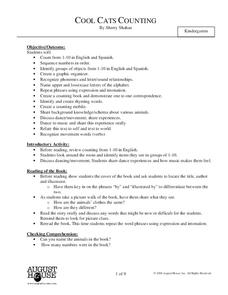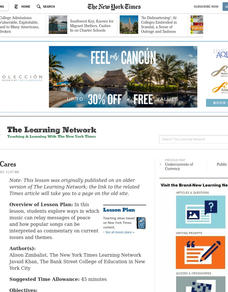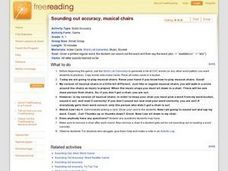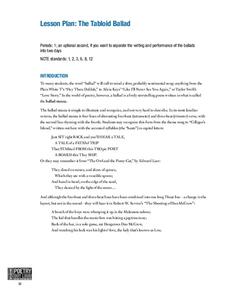Curated OER
Cool Cats Counting
Students practice number sense with the book Cool Cats Counting by Sherry Shahan. In this number lesson, students listen to the book and count from 1-10 in English and Spanish. They practice their alphabet, rhyming words, and...
Curated OER
The Cinder-Eyed Cats - Storybook Theater
The students listen to the story "The Cinder-Eyed Cats." The students then chose individual parts to play in a theater like production. The students move like their character, be it a fish, an octopus, a lobster, a cat, etc. Water music...
Curated OER
Musical Cares
Learners explore ways in which music can relay messages of peace and how popular songs can be interpreted as commentary on current issues and themes.
Curated OER
The Last Meow
Young scholars explore the popular culture phenomenon of the musical 'Cats' and the T.S. Eliot poems that were its inspiration. They write original poems about animals, and read them aloud to their peers.
Curated OER
Poetry through Jazz, Rap, and Hip Hop
Young scholars explore poetry through jazz, rap, and hip hop music. They discover the common threads that run through the poetry and music. Students design their own lyrics to a jazz, rap, or hip hop selection and share their songs...
Curated OER
Dr. Seuss Day
First graders celebrate Dr. Seuss's Birthday. Moving through six stations in small groups, first graders rotate on the teacher's signal through several engaging activities connected to Dr. Seuss's books and poetry.
Curated OER
Language: Has the Cat Got Your Tongue?
Use funny tongue twisters to entice your young learners! They'll love this game where they face off against members of the other team and recite tongue twisters. Who will win this enunciation and pronunciation competition!
Curated OER
Sounding out accuracy, Musical Chairs
Here is a great spin on the classic game, Musical Chairs! Instead of fighting to get the last chair when the music stops, learners will need to read a CVC word to stay in the game. They walk around, whoever is near the word bucket when...
Curated OER
Can You Hear a Story?
Young scholars listen to, analyze, and describe music. They explain relationships between music, the other arts, and disciplines outside the arts.
Curated OER
Musical Note Value
Students will identify each symbol by sight stating the value of each. They will use cardboard notes to who what they have learned so far about the note values creating 4 and 6 count phrases.
Florida Center for Reading Research
Rhyme or No Rhyme
Scholars listen to a rhyming song, clap when they hear a rhyme, and shake their heads when they don't. They then draw a pair of objects that rhyme.
Poetry Out Loud
The Tabloid Ballad
What do the theme song from Gilligan's Island, the nursery rhyme "The Owl and the Pussy-Cat," and the poem "The Shooting of Dan McGrew" all have in common? Why, they're ballads of course! Challenge your young balladeers to compose their...
Perkins School for the Blind
Learning to Identify Sounds Made by the Body
Sneeze, snap, tap, and whistle; Did I do that? Explore the parts and sounds of the human body with your learners with visual impairments. First you'll name the parts of the body, make a sound with each part, and then have the class...
Curated OER
Kitty Tunes
Students compare cat calls. In this wildlife lesson, students listen to cat calls and compose their own raps that feature the calls of Florida panthers.
Curated OER
Dynamics
Third graders recognize and identify the three types of balance. They analyze and identify the type of balance used in various works of art. Students create a symmetrically balanced work of art. They use a ruler, shape templates, an...
Curated OER
I See The Rhythm : The Study of Blues and Jazz
Students gain an appreciation for various types of music. Using the music of the past, they compare it with the music of today. In groups, they research periods in which blues and jazz were most popular and write their own piece of music...
Curated OER
Learning through The Duke
Students examine the important contributions made by Duke Ellington to the field of jazz, as well as some of the factors that led to his involvement in the field. As they explore the language of the 1920's, connections will be drawn...
Curated OER
Can You Beat Jet Lag?
Learners examine the health condition of jet lag. Using mealworms, they test the effect of light on the development of them into adults. They answer discussion questions and examine the relationship of age and one's activity level.
Curated OER
Give My Regards to Broadway
Students investigate aspects of Broadway shows. They apply word attack skills to decide what the titles of actual Broadway shows mean. They discuss the history of Broadway shows and why they become successful before completing the...
Curated OER
Singing for the Animals
Students examine the correct attitudes and poster for a concert. In this "Singing for Animals" lesson, students created charts to diagram information about the homeless animals they were singing for. Students used correct diction and...
Curated OER
Rhythmic Expression
Students discover movement and expression to music/sound through a series of teacher-led exercises and role plays. This lesson is ideal for the middle school drama class with possibilities for adaptation to any level of drama or general...
Curated OER
Power Point Lesson Plan
Students create a multimedia animal research presentation based on the include criteria for both information and sideshow format. They follow directions on slide set-up from creating a slide to transitions and musical insertion.
Curated OER
Can You Hear a Story?
Young scholars gain an understanding of relationships between music and language arts. They analyze a story and create a musical composition that reflects and enhances the story. The musical accompaniment will be produced in a book on...
Curated OER
Words in the News: Phantom of the Opera Success
Young scholars discuss the recent success of the "Phantom of the Opera". They practice using new vocabulary associated with the musical. In groups, they work together to match the word with its definition.

























